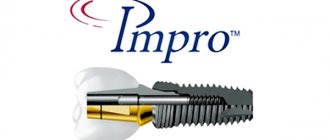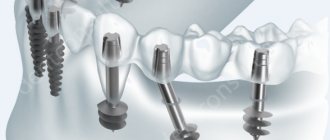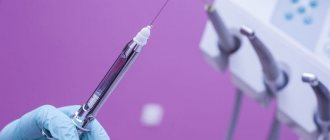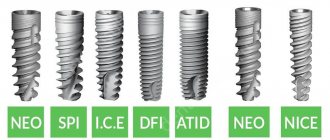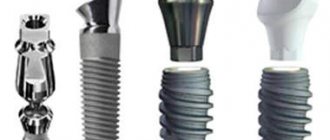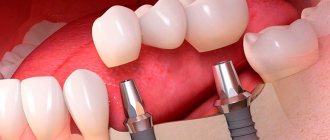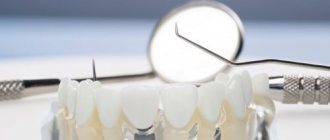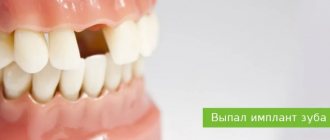Impro ICX Semados Ankylos Xive
Russian patients like implants from Germany for their long service life. Many of them come with a lifetime warranty. Product quality is confirmed by certificates of the European Union and the ISO 13485 quality system for medical products.
Implantologists appreciate them because the system can be selected for any clinical case. In addition, all implantation protocols are carefully worked out, which reduces complications to a minimum.
Among the countries that produce implants, Germany occupies one of the leading places, primarily because manufacturers rely on a strong scientific base. Scientists are developing new types of surfaces, threads, and shapes of implants to increase the survival rate and accelerate osseointegration. Reputable medical journals regularly publish research data that confirms a high percentage of successful engraftment.
There are several types of German implants on the Russian dental services market.
Impro
The German Impro implant system was created to satisfy all the needs of dentists and patients. More than 50 models, including super short ones, 7mm. Various models of abutments with which you can use any type of fixation: cement, screw, magnetic, cement-screw.
The main advantage of this company’s systems is the ability to install implants simultaneously with sinus lifting.
These products have:
- the innovative SuperH surface promotes osseointegration
; - the combination of micro and macro threads tightens the tissue
already during implantation; - a cone-shaped head with micro-thread allows the pin to be used even in thin bone
(1-2 mm); - the variety of abutments opens up wide possibilities for prosthetics
; - The pin design promotes even load distribution
.
Impro implants can be installed immediately after tooth extraction, without waiting for the socket to heal.
Impro implants are German quality at a price in the middle segment.
The disadvantages include the fact that the company does not use the sandblasting method to increase primary stability. The surface of the implants is not as rough as premium brands. It is not enriched with phosphorus or fluorine. The degree of surface hydrophilicity is average. On the other hand, a study of the surface cleanliness of implants from this brand notes the absolute absence of microflora and the extremely precise geometry of the products
[1].
IMPLANTOLOGISTS WHO INSTALL ZIRCONIUM IMPLANTS
The complexity of installing BREDENT zirconium implants is compensated by their long service life. However, this complexity does not in any way concern our patients.
The clinic’s implantologist surgeon, Dr. Petr Vladimirovich Ozerov, has 17 years of clinical experience, is a member of the Russian Dental Association and is certified by BREDENT to install zirconium implants.
The professionalism of our implantologist is recognized by a professional society.
Our clinic hosts educational courses in which Petr Vladimirovich, in lecture and practical parts, trains implantologists from the Russian Federation and the CIS in techniques for installing zirconium implants.
By choosing our clinic, you get a leading specialist in the Russian Federation, high-quality implants and the best level of service in the Russian Federation.
The implantologist has been a full member of the Russian Association of Dental Implantology since 2012.
ICX
ICX implants are not so widely known in Russia. However, the brand ranks 4th among implant manufacturers in Germany. And supplies products to 40 countries.
Why dentists recommend ICX:
- The range is small, but it contains implants for most clinical cases
. Products are offered for anterior and molar teeth, and pins for use in cases of significant bone loss and thin alveolar ridges. - Active Liquid surface accelerates osseointegration
by 2 times due to increased hydrophilicity. - The beveled, roughened shoulder of the implant provides primary stability
in the alveolar ridge and rapid growth of soft tissue. - Each pin uses 3 types of threads: self-tapping apical, condensation in the middle part and microthread in the neck. This combination compacts the bone tissue during installation, provides stability
during the healing period, and
distributes pressure evenly
during immediate loading.
Disadvantages of the system: the production of only 5 models limits the scope of application.
Indications and contraindications for installation
Products of the German brand are recommended for:
- loss of one/several teeth in a row;
- the need to restore a tooth with a narrow alveolar ridge, loose atrophied bone;
- the patient’s reluctance or the presence of contraindications to wearing a removable denture.
Contraindications to surgery include:
- blood clotting diseases;
- malignant neoplasms;
- any infectious diseases in the acute stage;
- serious disorders of the central nervous system, etc.
Would you like us to call you back?
Semados
Semado – German-made implants from Bego
. A distinctive feature of Bego products is their focus on digital technologies. This company was the first to use CAD/CAM technology, and is now actively distributing its own Varseo 3D printer to solve dental problems. Semados implants are recognized as the best in Europe in the “Production Safety” category.
Scientific studies have confirmed that the survival rate
Semados implants remain at the same level
5 and 9 years
[2] after surgery.
The model range is limited, but there are implants for one-stage and two-stage protocols, mini implants and pins for loose bone tissue.
The focus on digital technologies limits the use of German Semados implants in Russia. Only in large cities there are clinics that have high-tech equipment to work with this system.
The following 2 brands entered Russian dental practice like German ones. They continue to be called that, although technically they have already become international. As a result of several mergers, Ankylos and Xive implants are now manufactured by Dentsply Sirona.
How to choose the best dental implants?
The question of why prices for dental implants differ is of concern to most patients. Of course, at first glance, the difference is almost invisible: all such structures have an identical structure in the form of a small pin with a cylindrical or cone-shaped shape. Then what is the reason for the appearance of markups on some products, and the availability of affordable prices for others?
First of all, the inflated cost is due to the popularity of the brand. This allows you to understand which dental implants are the best . If a manufacturer has been on the market for several decades (for example, ]Straumann[/anchor], Astra or Nobel), invests significant funds in scientific research and the production of more advanced dental products, then you have to pay a significant amount extra just for its authority and name.
However, it is not only company recognition that matters: clinical parameters play a key role. Next, we will talk about the main indicators that characterize individual dental implants and help you decide which ones are best to install.
The likelihood of survival is the main factor in the ranking of implants
An important parameter indicating which implants are best placed is the degree of survival. As a rule, it is considered quite high for systems from popular manufacturers (over 97%), and reaches maximum values (100%) for elite brands, as proven by numerous studies. It should be noted that the rating of dental implants according to this criterion is considered conditional, since the final result of treatment is often determined by the professional skills of the doctor and the patient’s compliance with recommendations during the rehabilitation period.
Options for prosthetics when choosing implants
This factor is of great importance, since the functional and aesthetic characteristics of the installed implants are determined by the quality of the installation of the prostheses. Each brand has its own options for prosthetics - an “orthopedic portfolio”. That is, the more solutions for fixing crowns an orthopedist has, the more opportunities open up for the patient to obtain a successful treatment result even in complex clinical cases. This also allows patients to make a choice about which implants are best to place.
Ankylos
Back in 1985, Ankylosis implants made a small revolution in implantology. The abutment (base for the crown) and the implant itself were inserted into each other, forming a single system. This design has no gaps, which means pathogenic microbes cannot penetrate inside. The main idea remained the brand’s calling card, but was supplemented by new developments - the TissueCare concept.
Ankylos manufacturers decided to pay special attention to soft fabrics. All innovations are aimed at ensuring that implantation stimulates them to grow:
- The post design combined with the concave abutment provides ideal space for bone and soft tissue growth and preservation
. - The surface that has been sandblasted and acid etched increases the adhesion area. This accelerates osseointegration
. - Special thread facilitates installation
and
maintains alveolar ridge height
/
The survival rate of German Ankylos dental implants is 97%
[3] 5 years after installation.
to the cons
The brand's products include the need for special training, relatively high cost, as well as model limitations in the combination of length and diameter. for example, an implant with the largest diameter of 7mm does not have a model longer than 14mm. This somewhat limits installation options.
INSTALLATION OF A ZIRCONIUM IMPLANT IN A PATIENT WITH AN ALLERGY TO TITANIUM
We bring to your attention a complex clinical case of rehabilitation of a patient using zirconium prostheses.
Patient Tatyana Dmitrievna contacted the Bionic Dentis dental clinic with the need to install dental implants in place of lost teeth.
A concomitant problem of the patient was an allergy to metal.
We conducted a Titanium Tolerance Test, which showed a high level of allergic reaction to titanium implants and the impossibility of using metal implants.
It was decided to install a BREDENT zirconium implant.
The patient underwent implantation surgery and installation of a zirconium dioxide crown.
An excellent result was obtained.
There is no implant rejection.
Clinical effect 10 out of 10;
Xive
German Xive dental implants have a high level of survival rate
[4] in its product class. The special thread design provides primary stability even with significant bone loss.
Advantages:
- Can be used for any type of prosthetics
. Single pins, bridges or a full jaw – any type of orthopedic treatment is available. - Suitable for immediate implantation
. Implantation into the socket of an extracted tooth prevents bone loss and allows you to immediately use temporary dentures. - Maintains gum contour
. The smooth neck of the implant and the special design of the abutment give the gum a natural appearance.
The thread on the pin becomes denser in the cortical part. This guarantees optimal stability. Varieties of abutments help you choose the right one for temporary and permanent crowns.
The disadvantages of the system include the fact that it is not so well known in the regions. In the outback it is difficult to find a dentistry that offers the installation of implants of this brand.
Manufacturers from Germany on the Russian market
- The German corporation DENTSPLY Friadent produces XiVE implants in the mid-price segment. The porous surface makes it possible to install into loose bone and ensures good survival. ANKYLOS systems, also from DENTSPLY Friadent, are premium systems. They are characterized by a low level of trauma and accelerated osseointegration, eliminating the formation of gaps between the artificial root and bone tissue.
- DENTI System differs from its competitors by producing zirconium structures with the highest level of aesthetics and minimal risk of rejection.
- Bego SEMADOS has developed a special form of implant that eliminates the formation of a micro-gap between the neck of the artificial tooth and the gum, where pathogenic microorganisms can accumulate. This eliminates the development of inflammation and other complications.
- Helmut Knigel has developed a line of Impro dental structures, the surface of which is similar to a natural tooth root, which reduces the period of osseointegration, and self-tapping threads reduce tissue damage during surgery.
- The ADM company has released ICX systems that are not inferior in quality to the previous ones. But if you compare their price with analogues, it will turn out to be significantly lower.
- Separately, it is worth highlighting the German company Green Implant System Technology . It appeared quite recently, but thanks to innovative technologies it quickly took one of the leading positions in the ranking of leading German manufacturers. The specialists working here have developed a modular implant that allows, in case of bone atrophy, to replace only its upper part, leaving the inner segment of the artificial root intact.

